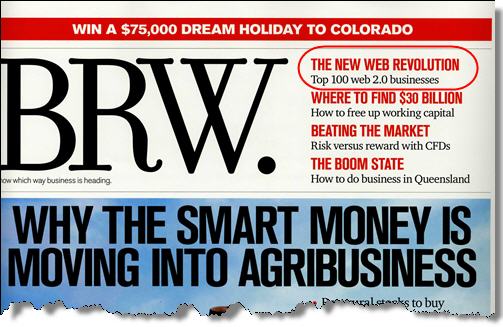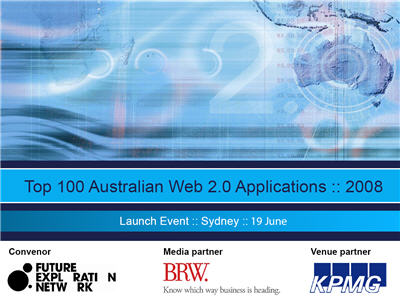Official launch of the Top 100 Australian Web 2.0 Applications list
The Top 100 Web 2.0 Applications list is now officially launched – the full list is below, after appearing this morning in a feature section in BRW magazine on Web 2.0. A few quick comments:
* See the scope and criteria for the list.
* No doubt many will disagree with what has or hasn’t been included in the list. That’s inevitable in drawing boundaries around defining Web 2.0 applications. We have been strict in applying our scope, and many very worthy applications have not been included in the list, not because they’re not excellent, but because they haven’t met our judge’s view of what constitutes a Web 2.0 application.
* A few more applications have come to our attention since the list was finalized. In a very dynamic landscape we cannot hope to cover everything, but we are continuing to build as comprehensive a view of the landscape as possible. Please let us know what we’re missing.
* Despite the caveats above, we’re very happy with the list and what has come out of our efforts in creating it. It provides the broadest coverage of the Australian Web 2.0 landscape available, and we are sure will achieve its intention of supporting and drawing attention to the value created by Australia’s vibrant online entrepreneurial community. I hope and expect that the 2009 list will once again represent a far deeper and richer landscape featuring many global success stories.
1. mig33
Website: https://www.mig33.com/
Person/Company: Project Goth (Steven Goh/ Mei Lin Ng)
Description: Global mobile and web-based community, including social networking and messaging such as IM, email, text and photo sharing. Founded in 2005 in Perth and now based in the US. Has raised US$23 million, and has over 7 million users across 200 countries.
2. Confluence
Website: https://www.atlassian.com/
Person/Company: Atlassian (Mike Cannon-Brookes/ Scott Farquhar)
Description: Enterprise wiki with 5,000 clients in over 80 countries. Based in Sydney and San Francisco. Atlassian has over $22 million in revenue with no external funding.
3. Red Bubble
Website: https://www.redbubble.com/
Person/Company: Martin Hosking/ Peter Styles/ Paul Vanzella
Description: Art gallery and creative community where artists can upload art and sell it in many formats. Over 100,000 items sold in 71 countries in the first financial year. Has raised $3.7 million in funding.
4. 3eep
Website: https://www.3eep.com/
Person/Company: Rob Antulov/ Nick Gonios
Description: Social networking platform covering sports from national to school level for sports enthusiasts, players, teams and parents, allowing discussions and photo and video sharing. Has licensed the platform in Australia, Canada and Germany, and is also run as a stand-alone social network.
5. Engagd
Website: https://www.engagd.com/
Person/Company: Faraday Media (Chris Saad/ Ashley Angell)
Description: Web service application that creates ‘attention profiles’ of users, and enables these to be used in customising services and content for users.







